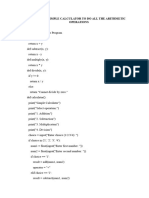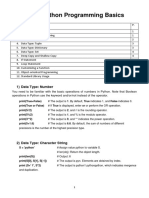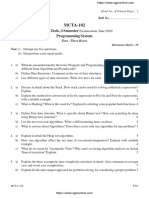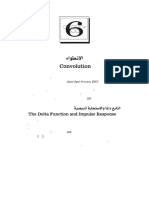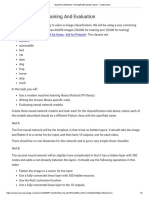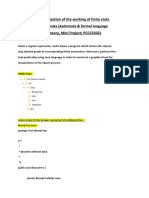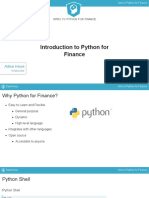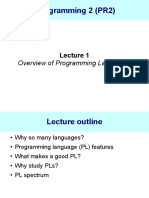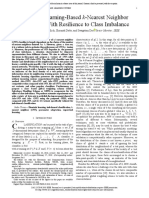EX NO:1
a)Flow control
AIM:
To write a python program to find whether a number is odd or even using
flow control.
ALGORITHM:
Step 1:Start the program.
Step 2:Read input number from the user.
Step 3:Divide the number by 2 and check the remainder.
Step 4:If the remainder is 0,the number is even.
Step 5:Display the result.
Step 6: Stop the program.
EX NO:1 ( A) FLOW CONTROL
CHECKING IF A NUMBER IS ODD OR EVEN
num=int(input("enter a number:"))
if num%2==0:
print(num,"is even")
else:
print(num,"is odd")
OUTPUT
EX No:1
B) Functions
AIM:
To write a python program using function to calculate the area of a circle
ALGORITHM:
Step 1:Start the program.
Step 2 Read the radius of the circle from the user.
Step 3:Define a function named calculate the area that takes the radius as a
Parameter.
Step 4:Inside the function calculate the area of the circle using the formula area
=pi* reading where pi is constant value.
Step 5:Return the calculate area from function.
Step 6:Call the calculate area of function with the input radius as an argument.
Step 7:Store the returned area value in a variable.
Step 8:Display the calculate Area.
Step 9:Stop the program.
EX NO:1 (B)FUNCTION
CALCULATE THE AREA OF CIRCLE
import math
def calculate_area(radius):
area=math.pi*radius*radius
return area
radius=float (input("Enter the radius of the circle;"))
area=calculate_area(radius)
print ("The area of the ciecle is:",area)
OUTPUT:
EX NO:1
C) STRING MANIPULATION
AIM:
To write a python program using string manipulation to reverse a given string.
ALGORITHM:
Step 1:Start the program.
Step 2:Read the Input string from the user.
Step 3:Define the function named reversed string that takes the string as a
Parameter.
Step 4:Inside the function are string slicing with a step of 1 to reverse string.
Step 5:Return the reversed string from function.
Step 6:Call the reversed string from the input string as a argument.
Step 7:Store the returned reversed string in a variable.
Step 8:Display the reversed string.
Step 9:Stop the program.
EX NO:1 C) STRING MANIPULATION
REVERSING A STRING
def revers_string(string)
revers_string=string[::-1]
return revers_string
text=input("enter a string:")
revers_text=reverse_string(text)
print("reversed string:",revers_text)
OUTPUT:
RESULT:
Thus the program is executed successfully.
EX NO:2
A)OPERATIONS ON TUPLES
AIM:
To write a python program to find maximum and minimum values in tuple.
ALGORITHM:
Step 1:Start the program.
Step 2:Define a tuple containing a set of numbers
Step 3:Initialize variables maximum and minimum with the first element of the
tuple
Step 4:Iterate through the tuple starting from the second element.
Step 5:If the current element is greater than maximum update maximum.
Step 6:If the current element is smaller than minimum update minimum.
Step 7:After iterating through all elements display the results.
Step 8:Stop the program.
EX NO:2 OPERATIONS ON TUPLES AND LISTS
(A)FINDING MAXIMUM AND MINIMUM ELEMENTS IN A TUPLE
numbers=(10,30,20,5,15)
maximum=minimum=numbers[0]
for num in numbers[1:]:
if num>maximum:
maximum=num
if num<minimum:
minimum=num
print("maximum:", maximum)
print("minimum:", minimum)
OUTPUT:
EX NO:2
B)OPERATIONS ON LIST
AIM:
To write a python program to find the sum of elements in a list.
ALGORITHM:
Step 1:Start the program.
Step 2:Define a list Containing a set of numbers.
Step 3:Initilize a variable total to zero.
Step 4:Iterate through the list and add each element to total.
Step 5:Display the sum total.
Step 6:Stop the program.
EX NO:2 (B) LISTS
FINDING THE SUM OF THE LISTS
numbers = [10, 20, 30, 40]
total = sum(numbers)
print("Sum of the list:", total)
OUTPUT:
RESULT:
Thus the program is executed successfully.
EX NO:3
OPERATIONS ON SETS
AIM:
To write a python program to perform various operations on set.
ALGORITHM:
Step1:Start the program.
Step 2:Define the sets with different elements.
Step 3:Perform various operations on the sets.
a) Union: find the union of the two sets using the union () method.
b) Intersection : find the intersection of the Two sets using the intersection () method.
c) Difference: Find the difference between the two sets using the difference()method.
Step 4:Display the result of operations.
Step 5:Stop the program.
EX NO:3 OPERATIONS ON SETS
set1 = {1, 2, 3, 4, 5}
set2 = {4, 5, 6, 7, 8}
union_set = set1.union(set2)
intersection_set = set1.intersection(set2)
difference_set = set1.difference(set2)
symmetric_difference_set = set1.symmetric_difference(set2)
print("union:", union_set)
print("intersection:", intersection_set)
print("difference:", difference_set)
print("symmetric difference:", symmetric_difference_set)
OUTPUT:
RESULT:
Thus the program is executed successfully.
EX NO:4
OPERATION ON DICTIONARY
AIM:
To write a python programming to perform various operations on dictionary.
ALGORITHM:
Step 1: Start the program.
Step 2: Define a dictionary with key-value pair.
Step 3: Perform various operations on the dictionary.
a) Accessing values : retrieve the value of specific key from the dictionary using the
inside square brackets
b) Adding key-values pair. Add a new key-specific key in the dictionary.
c) Removing key-value pairs : Remove a specific key value pair from
the dictionary.
Step 4: Display the result of the operations.
Step 5: Stop the program..
EX NO:4 OPERATIONS ON DICTIONARY
student_scores = {
"john": 85,
"slice": 92,
"bob": 78,
"emily": 95,
print("Accessing value:")
print("john's score:", student_scores["john"])
print("\nModifying value:")
student_scores["alice"] = 90
print("Updated score for alice:", student_scores["alice"])
print("\nAdding key-value pair:")
student_scores["david"] = 88
print("Added david's score:", student_scores["david"])
print("\nRemoving key-value pair:")
del student_scores["bob"]
print("bob's score removed.")
print("\nIterating through keys and values:")
for name, score in student_scores.items():
print(name, "scored", score)
OUTPUT:
RESULT:
Thus the program is executed successfully.
EX NO:5
SIMPLE OPP – CONSTRUCTORS CREATE A CLASS FROM
REPRESTING CAR
AIM:
To write a python program with simple oop by creating a class car with
Constructors.
ALGORITHM:
Step 1:Start the program.
Step 2:Defined a class named car.
Step 3:Inside the class,define a constructor method _init_() that takes a parameters
for the car’s make, model, year.
Step 4:Initialize instance variables using the constructor parameters.
Step5:Create an instance of the car, class , providing values of the car make,
models, year.
Step6:Access and display the car attributes.
Step7:Stop the program.
EX NO:5 SIMPLE OPP-CONSTRUCTORS CREATE A CLASS FOR REPRESENING A CAR
class Car:
def __init__(self, make, model, year, color):
self.make = make
self.model = model
self.year = year
self.color = color
my_car = Car("Toyota", "Corolla", 2020, "Blue")
print("make:",my_car.make)
print("model:",my_car.model)
print("year:",my_car.year)
OUTPUT:
RESULT:
Thus the program is executed successfully.
EX.NO:06
METHOD OVERLOADING –CREATE CLASSES FOR VECHICLE
AND BUS AND DEMONSTRATE
AIM:
Write a program using method over-loading
ALGORITHM:
Step 1: Start the program.
Step2: Define a class named ‘vehicle’
Step 3:Inside the class vehicle ,define method name ‘accelerate’ that takes single parameter
‘speed’
Step4:Define a class name ‘bus’ which inhert from the class ‘vehicle’
Step5:Inside bus class define an overloaded accelerate on that takes a 2 parameter ‘speed’,
’gear’.
Step6:Create the instances of the class vehicle & bus.
Step7:Call the accelerated method on birth instance with different set of parameter.
Step8:Display the result.
Step9:End the program.
EX NO:6
METHOD OVERLOADING – CREATE CLASSES FOR VEHICLE AND BUS AND
DEMONSTRATE
class vehicle:
def accelerate(self, speed):
print("vehicle is accelerating to",speed, "km/h")
class bus(vehicle):
def accelerate(self, speed, gear):
print("bus is accelerating to",speed, "km/h in", gear, "gear")
car=vehicle()
bus=bus()
car.accelerate(100)
bus.accelerate(80,4)
OUTPUT:
RESULT:
Thus the program is executed successfully.
EX.NO.:07
FILES-READING AND WRITING-PERFORM THE BASIC
OPERATION OF READING AND WRITING WITH STUDENT FILE
AIM:
To write a program to perform the basic reading and writing operation from the student file.
Algorithm:
step1:Start the program.
Step2:Define a function that reads student information “read student()”.
Step3:Definr a function that write information “write student()”.
Step4:Call read function to read and display the existing students information from file.
Step5:Call write fuction to add the information of new students to file and display.
Step6:Again call the read student to read and display the updated student information.
Step7:End of program.
EX NO:7 FILES-READING AND WRITING PERFORM THE BASIC OPERATION OF
READING AND WRITING WITH STUDENT FILE
def read_students():
print("Student Information:")
try:
with open("students.txt", "r") as file:
for line in file:
name, score = line.strip().split(",")
print("Name:", name, "Score:", score)
except FileNotFoundError:
print("No student data found yet.")
def write_students():
name = input("Enter student name: ")
score = input("Enter student score: ")
with open("students.txt", "a") as file:
file.write(name + "," + score + "\n")
print("Student information added successfully.")
write_students()
read_students()
OUTPUT:
RESULT:
Thus the program is executed successfully.
EX.NO:08
REGULAR EXPRESSIONS
AIM:
To write a program to extract email address from a text .
Algorithm:
Step1:Start the program.
Step2:Import re module the supports regular expression.
Step3:Define a regular expression pattern that matches an email address.
Step4:Read a text input from user .
Step5:Use, the re.find al l () function to find all the occurrences of the email address and
return them as a list.
Step6:Display the extracted email address.
Step7:End the program.
EX NO 8: REGULAR EXPRESSIONS
import re
pattern = r'^[\w\.-]+@[\w\.-]+\.\w+$'
email = input("Enter an email address: ")
if re.match(pattern, email):
print("Valid email address.")
else:
print("Invalid email address.")
OUTPUT:
RESULT:
Thus the program is executed successfully.
EX.NO:09
MODULE
AIM:
To write a program using module to perform mathematical operations.
Algorithm:
Step1:Start the program.
Step2:Import math module which support mathematical fuctions.
Step3:Read the input from the user.
Step4:Use various operations from the math module such as:
(i)Square root
(ii)logarithmic function &
(iii)Trignometric function.
Step5:Display the result.
Step6:End the program
EX NO:9 MODULE
import math
number = float(input("Enter a number: "))
# Square root (note: function is 'sqrt', not 'sqr')
square_root = math.sqrt(number)
print("Square root:", square_root)
# Trigonometric functions (use 'sin', not 'sine')
sine = math.sin(number)
print("Sine:", sine)
cosine = math.cos(number)
print("Cosine:", cosine)
tangent = math.tan(number)
print("Tangent:", tangent)
# Logarithms
log_base10 = math.log10(number)
print("Logarithm (base 10):", log_base10)
natural_log = math.log(number)
print("Natural logarithm (base e):", natural_log)
OUTPUT:
RESULT:
Thus the program is executed successfully.
EX.NO:10
PACKAGE
AIM:
To perform mathematical function using a package.
Algorithm
Step1:Start the program.
Step2:Create a folder named calculator
Step3:Inside the calculator folder create a file named “calculator. py” Which institute
function such as.
(i)def add
(ii)def sub
(iii)def mul
(iv)def divi
Step4:Create a another file named ‘init.py’ referred to package in the folder.
Strp5:Create another file “package.py” inside the folder calculator and declare the directory
path for the folder calculator.
Step6:Run the package file.
Step7:Print the display.
Step8:End the program.
EX NO 10 : PACKAGE
basic:
def add(a, b):
return a + b
def subtract(a, b):
return a - b
advanced:
def multiply(a, b):
return a * b
def division(a, b):
return a / b
main:
from math_operations.basic import add,sub
from math_operations.advanced import multiply,divide
num1 = float(input("Enter the first number: "))
num2 = float(input("Enter the second number: "))
result_add = add(num1, num2)
result_subtract = subtract(num1, num2)
result_multiply = multiply(num1, num2)
result_divide = division(num1, num2)
print("Addition:", result_add)
print("Subtraction:", result_subtract)
print("Multiplication:", result_multiply)
print("Division:", result_divide)
OUTPUT:
RESULT:
Thus the program is executed successfully.
EX.NO:11
EXCEPTION HANDLING
AIM:
To write a program to perform the division operation on exception handling.
Algorithm:
Step1:Start the program.
Step2:Read two numbers, numerator and denominator from the user.
Step3:Wrap the division operation inside try-except block to handle potential exceptions.
Step4:Perform the division operation inside try block.
Step5:If the division is successfully print the try result.
Step6:If the zero division error occurs catch the exception in the except block.
Step7:Display an error message indicating that division by zero is not allowed.
Step8:End the program.
EX NO:11 EXCEPTION HANDLING
numerator=float(input("enter the numerator:"))
denominator=float(input("enter the denominator:"))
try:
result=numerator/denominator
print("result:",result)
except zerodivisionerror:
print("error division by zero is not allowed")
OUTPUT:
RESULT:
Thus the program is executed successfully















